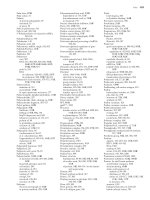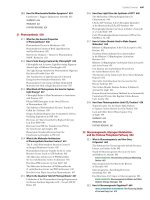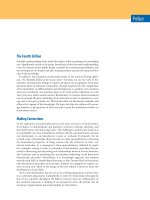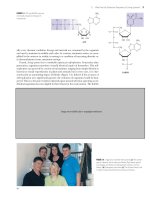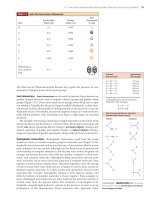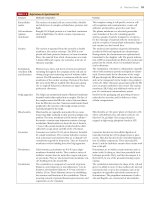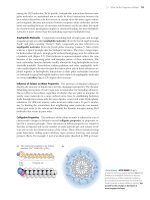Plant biochemistry 4th edition by water heldt and piechulla
Bạn đang xem bản rút gọn của tài liệu. Xem và tải ngay bản đầy đủ của tài liệu tại đây (5.13 MB, 647 trang )
Plant Biochemistry
Fourth edition
This page intentionally left blank
Plant
Biochemistry
Hans-Walter Heldt
Birgit Piechulla
in cooperation with Fiona Heldt
Translation of the 4th German edition
AMSTERDAM • BOSTON • HEIDELBERG • LONDON
NEW YORK • OXFORD • PARIS • SAN DIEGO
SAN FRANCISCO • SINGAPORE • SYDNEY • TOKYO
Academic Press is an imprint of Elsevier
Academic Press is an imprint of Elsevier
32 Jamestown Road, London NW1 7BY, UK
30 Corporate Drive, Suite 400, Burlington, MA 01803, USA
525 B Street, Suite 1800, San Diego, CA 92101-4495, USA
Fourth edition 2011
Translation © Elsevier Inc.
Translation from the German language edition:
Pflanzenbiochemie by Hans-Walter Heldt and Birgit Piechulla
Copyright © Spektrum Akademischer Verlag Heidelberg 2008
Spektrum Akademischer Verlag is an imprint of Springer-Verlag GmbH
Springer-Verlag GmbH is a part of Springer ScienceϩBusiness Media
All Rights Reserved
No part of this publication may be reproduced, stored in a retrieval system
or transmitted in any form or by any means electronic, mechanical, photocopying,
recording or otherwise without the prior written permission of the publisher
Permissions may be sought directly from Elsevier’s Science & Technology Rights
Department in Oxford, UK: phone (ϩ44) (0) 1865 843830; fax (ϩ44) (0) 1865 853333;
email: Alternatively, visit the Science and Technology Books
website at www.elsevierdirect.com/rights for further information
Notice
No responsibility is assumed by the publisher for any injury and/or damage to persons
or property as a matter of products liability, negligence or otherwise, or from any use or
operation of any methods, products, instructions or ideas contained in the material herein.
Because of rapid advances in the medical sciences, in particular, independent verification of
diagnoses and drug dosages should be made
British Library Cataloguing-in-Publication Data
A catalogue record for this book is available from the British Library
Library of Congress Cataloging-in-Publication Data
A catalog record for this book is available from the Library of Congress
ISBN : 978-0-12-384986-1
For information on all Academic Press publications
visit our website at elsevierdirect.com
Typeset by MPS Limited, a Macmillan Company, Chennai, India
www.macmillansolutions.com
Printed and bound in United States of America
10 11 12 13 14 15
10 9 8 7 6 5 4 3 2 1
Dedicated to my teacher, Martin Klingenberg
Hans–Walter Heldt
This page intentionally left blank
Contents
Preface xxi
Introduction xxiii
1
A leaf cell consists of several metabolic compartments
1
1.1
The cell wall gives the plant cell mechanical stability
4
The cell wall consists mainly of carbohydrates and proteins
Plasmodesmata connect neighboring cells 7
1.2
1.3
1.4
1.5
1.6
1.7
1.8
1.9
4
Vacuoles have multiple functions 9
Plastids have evolved from cyanobacteria 11
Mitochondria also result from endosymbionts 15
Peroxisomes are the site of reactions in which toxic intermediates
are formed 17
The endoplasmic reticulum and Golgi apparatus form a network
for the distribution of biosynthesis products 18
Functionally intact cell organelles can be isolated from plant
cells 22
Various transport processes facilitate the exchange of metabolites
between different compartments 24
Translocators catalyze the specific transport of metabolic substrates
and products 26
Metabolite transport is achieved by a conformational change of the
translocator 28
Aquaporins make cell membranes permeable for water 31
1.10
1.11
Ion channels have a very high transport capacity
Porins consist of β-sheet structures 37
Further reading 40
32
2
The use of energy from sunlight by photosynthesis is the basis of life
on earth 43
2.1
2.2
How did photosynthesis start? 43
Pigments capture energy from sunlight
45
The energy content of light depends on its wavelength
Chlorophyll is the main photosynthetic pigment 47
45
vii
viii
Contents
2.3
2.4
Light absorption excites the chlorophyll molecule
An antenna is required to capture light 54
50
How is the excitation energy of the photons captured in the antennae
and transferred to the reaction centers? 56
The function of an antenna is illustrated by the antenna of
photosystem II 57
Phycobilisomes enable cyanobacteria and red algae to carry out
photosynthesis even in dim light 60
Further reading
64
3
Photosynthesis is an electron transport process
3.1
3.2
The photosynthetic machinery is constructed from modules 65
A reductant and an oxidant are formed during
photosynthesis 69
The basic structure of a photosynthetic reaction center has been
resolved by X-ray structure analysis 70
3.3
65
X-ray structure analysis of the photosynthetic reaction center 72
The reaction center of Rhodopseudomonas viridis has a symmetrical
structure 73
3.4
3.5
3.6
How does a reaction center function? 75
Two photosynthetic reaction centers are arranged in tandem in
photosynthesis of algae and plants 79
Water is split by photosystem II 82
Photosystem II complex is very similar to the reaction center in purple
bacteria 86
Mechanized agriculture usually necessitates the use of herbicides 88
3.7
The cytochrome-b6/f complex mediates electron transport
between photosystem II and photosystem I 90
Iron atoms in cytochromes and in iron-sulfur centers have a central
function as redox carriers 90
The electron transport by the cytochrome-b6/f complex is coupled to a
proton transport 93
The number of protons pumped through the cyt-b6/f complex can be
doubled by a Q-cycle 96
3.8
Photosystem I reduces NADPϩ 98
The light energy driving the cyclic electron transport of PSI is only utilized
for the synthesis of ATP 101
3.9
In the absence of other acceptors electrons can be transferred from
photosystem I to oxygen 102
Contents
3.10
Regulatory processes control the distribution of the captured
photons between the two photosystems 106
Excess light energy is eliminated as heat
Further reading
108
110
4
ATP is generated by photosynthesis
4.1
A proton gradient serves as an energy-rich intermediate state
during ATP synthesis 114
The electron chemical proton gradient can be dissipated by
uncouplers to heat 117
4.2
113
The chemiosmotic hypothesis was proved experimentally
4.3
119
Hϩ-ATP synthases from bacteria, chloroplasts, and mitochondria
have a common basic structure 119
X-ray structure analysis of the F1 part of ATP synthase yields an insight
into the machinery of ATP synthesis 123
4.4
The synthesis of ATP is effected by a conformation change of the
protein 125
In photosynthetic electron transport the stoichiometry between the
formation of NADPH and ATP is still a matter of debate 128
Hϩ-ATP synthase of chloroplasts is regulated by light 129
V-ATPase is related to the F-ATP synthase 129
Further reading
130
5
Mitochondria are the power station of the cell
5.1
Biological oxidation is preceded by a degradation of substrates to
form bound hydrogen and CO2 133
Mitochondria are the sites of cell respiration 134
5.2
133
Mitochondria form a separated metabolic compartment
5.3
135
Degradation of substrates applicable for biological oxidation takes
place in the matrix compartment 136
Pyruvate is oxidized by a multienzyme complex 136
Acetate is completely oxidized in the citrate cycle 140
A loss of intermediates of the citrate cycle is replenished by anaplerotic
reactions 142
5.4
5.5
How much energy can be gained by the oxidation of NADH? 144
The mitochondrial respiratory chain shares common features with
the photosynthetic electron transport chain 145
5.6
Electron transport of the respiratory chain is coupled to the
synthesis of ATP via proton transport 151
The complexes of the mitochondrial respiratory chain
147
ix
x
Contents
Mitochondrial proton transport results in the formation of a membrane
potential 153
Mitochondrial ATP synthesis serves the energy demand of the cytosol 154
5.7
Plant mitochondria have special metabolic functions
155
Mitochondria can oxidize surplus NADH without forming ATP 156
NADH and NADPH from the cytosol can be oxidized by the respiratory
chain of plant mitochondria 158
5.8
Compartmentation of mitochondrial metabolism requires specific
membrane translocators 159
Further reading 160
6
The Calvin cycle catalyzes photosynthetic CO2 assimilation
6.1
CO2 assimilation proceeds via the dark reaction of
photosynthesis 163
Ribulose bisphosphate carboxylase catalyses the fixation of
CO2 166
6.2
163
The oxygenation of ribulose bisphosphate: a costly side-reaction 168
Ribulose bisphosphate carboxylase/oxygenase: special features 170
Activation of ribulose bisphosphate carboxylase/oxygenase 170
6.3
6.4
6.5
6.6
The reduction of 3-phosphoglycerate yields triose phosphate 172
Ribulose bisphosphate is regenerated from triose phosphate 174
Beside the reductive pentose phosphate pathway there is also an
oxidative pentose phosphate pathway 181
Reductive and oxidative pentose phosphate pathways are
regulated 185
Reduced thioredoxins transmit the signal “illumination” to the
enzymes 185
The thioredoxin modulated activation of chloroplast enzymes releases a
built-in blockage 187
Multiple regulatory processes tune the reactions of the reductive pentose
phosphate pathway 188
Further reading
190
7
Phosphoglycolate formed by the oxygenase activity of RubisCO is
recycled in the photorespiratory pathway 193
7.1
Ribulose 1,5-bisphosphate is recovered by recycling
2-phosphoglycolate 193
The NH4ϩ released in the photorespiratory pathway is refixed in
the chloroplasts 199
7.2
Contents
7.3
Peroxisomes have to be provided with external reducing
equivalents for the reduction of hydroxypyruvate 201
Mitochondria export reducing equivalents via a malate-oxaloacetate
shuttle 203
A “malate valve” controls the export of reducing equivalents from the
chloroplasts 203
7.4
7.5
7.6
7.7
The peroxisomal matrix is a special compartment for the disposal
of toxic products 205
How high are the costs of the ribulose bisphosphate oxygenase
reaction for the plant? 206
There is no net CO2 fixation at the compensation point 207
The photorespiratory pathway, although energy-consuming, may
also have a useful function for the plant 208
Further reading 209
8
Photosynthesis implies the consumption of water
8.1
The uptake of CO2 into the leaf is accompanied by an escape of
water vapor 211
Stomata regulate the gas exchange of a leaf 213
8.2
211
Malate plays an important role in guard cell metabolism
Complex regulation governs stomatal opening 215
8.3
8.4
213
The diffusive flux of CO2 into a plant cell 217
C4 plants perform CO2 assimilation with less water consumption
than C3 plants 220
The CO2 pump in C4 plants 221
C4 metabolism of the NADP-malic enzyme type plants 223
C4 metabolism of the NAD-malic enzyme type 227
C4 metabolism of the phosphoenolpyruvate carboxykinase type 229
Kranz-anatomy with its mesophyll and bundle sheath cells is not an
obligatory requirement for C4 metabolism 231
Enzymes of C4 metabolism are regulated by light 231
Products of C4 metabolism can be identified by mass spectrometry 232
C4 plants include important crop plants but also many persistent weeds 232
8.5
Crassulacean acid metabolism allows plants to survive even during
a very severe water shortage 233
CO2 fixed during the night is stored as malic acid 234
Photosynthesis proceeds with closed stomata 236
C4 as well as CAM metabolism developed several times during
evolution 238
Further reading
238
xi
xii
Contents
9
Polysaccharides are storage and transport forms of carbohydrates
produced by photosynthesis 241
Starch and sucrose are the main products of CO2 assimilation in many
plants 242
9.1
Large quantities of carbohydrate can be stored as starch in the
cell 242
Starch is synthesized via ADP-glucose 246
Degradation of starch proceeds in two different ways 248
Surplus of photosynthesis products can be stored temporarily in
chloroplasts as starch 251
9.2
9.3
Sucrose synthesis takes place in the cytosol 253
The utilization of the photosynthesis product triose phosphate is
strictly regulated 255
Fructose 1,6-bisphosphatase is an entrance valve of the sucrose synthesis
pathway 255
Sucrose phosphate synthase is regulated by metabolites and by covalent
modification 259
Partitioning of assimilates between sucrose and starch is due to the
interplay of several regulatory mechanisms 260
Trehalose is an important signal mediator 260
9.4
9.5
9.6
In some plants assimilates from the leaves are exported as sugar
alcohols or oligosaccharides of the raffinose family 261
Fructans are deposited as storage compounds in the
vacuole 264
Cellulose is synthesized by enzymes located in the plasma
membrane 268
Synthesis of callose is often induced by wounding 269
Cell wall polysaccharides are also synthesized in the Golgi apparatus
Further reading
270
270
10
Nitrate assimilation is essential for the synthesis of organic
matter 273
10.1
The reduction of nitrate to NH3 proceeds in two reactions
274
Nitrate is reduced to nitrite in the cytosol 276
The reduction of nitrite to ammonia proceeds in the plastids 277
The fixation of NH4ϩ proceeds in the same way as in the photorespiratory
cycle 278
10.2
Nitrate assimilation also takes place in the roots
280
The oxidative pentose phosphate pathway in leucoplasts provides reducing
equivalents for nitrite reduction 280
10.3
Nitrate assimilation is strictly controlled
282
Contents
The synthesis of the nitrate reductase protein is regulated at the level of
gene expression 283
Nitrate reductase is also regulated by reversible covalent modification 283
14-3-3 proteins are important metabolic regulators 284
There are great similarities between the regulation of nitrate reductase and
sucrose phosphate synthase 285
10.4
The end product of nitrate assimilation is a whole spectrum of
amino acids 286
CO2 assimilation provides the carbon skeletons to synthesize the end
products of nitrate assimilation 286
The synthesis of glutamate requires the participation of mitochondrial
metabolism 288
Biosynthesis of proline and arginine 289
Aspartate is the precursor of five amino acids 291
Acetolactate synthase participates in the synthesis of hydrophobic amino
acids 293
Aromatic amino acids are synthesized via the shikimate pathway 297
Glyphosate acts as a herbicide 297
A large proportion of the total plant matter can be formed by the shikimate
pathway 299
10.5
Glutamate is precursor for chlorophylls and cytochromes
Protophorphyrin is also precursor for heme synthesis
Further reading
300
302
304
11
Nitrogen fixation enables plants to use the nitrogen of the air for
growth 307
11.1
Legumes form a symbiosis with nodule-forming bacteria
308
The nodule formation relies on a balanced interplay of bacterial and plant
gene expression 311
Metabolic products are exchanged between bacteroids and host cells 311
Dinitrogenase reductase delivers electrons for the dinitrogenase reaction 313
N2 as well as Hϩ are reduced by dinitrogenase 314
11.2
11.3
11.4
N2 fixation can proceed only at very low oxygen
concentrations 316
The energy costs for utilizing N2 as a nitrogen source are much
higher than for the utilization of NOϪ
318
3
Plants improve their nutrition by symbiosis with fungi 318
The arbuscular mycorrhiza is widespread 319
Ectomycorrhiza supply trees with nutrients 320
11.5
Root nodule symbioses may have evolved from a pre-existing
pathway for the formation of arbuscular mycorrhiza 320
Further reading 321
xiii
xiv
Contents
12
Sulfate assimilation enables the synthesis of sulfur containing
compounds 323
12.1
Sulfate assimilation proceeds primarily by photosynthesis
Sulfate assimilation has some parallels to nitrogen assimilation
Sulfate is activated prior to reduction 325
Sulfite reductase is similar to nitrite reductase 326
H2S is fixed in the amino acid cysteine 327
12.2
Glutathione serves the cell as an antioxidant and is an agent for the
detoxification of pollutants 328
Xenobiotics are detoxified by conjugation 329
Phytochelatins protect the plant against heavy metals
12.3
323
324
Methionine is synthesized from cysteine
330
332
S-Adenosylmethionine is a universal methylation reagent
332
12.4
Excessive concentrations of sulfur dioxide in the air are toxic for
plants 334
Further reading 335
13
Phloem transport distributes photoassimilates to the various sites of
consumption and storage 337
13.1
13.2
13.3
There are two modes of phloem loading 339
Phloem transport proceeds by mass flow 341
Sink tissues are supplied by phloem unloading 342
Starch is deposited in plastids 343
The glycolysis pathway plays a central role in the utilization of
carbohydrates 343
Further reading
348
14
Products of nitrate assimilation are deposited in plants as storage
proteins 349
14.1
14.2
14.3
14.4
14.5
Globulins are the most abundant storage proteins 350
Prolamins are formed as storage proteins in grasses 351
2S-Proteins are present in seeds of dicot plants 352
Special proteins protect seeds from being eaten by animals 352
Synthesis of the storage proteins occurs at the rough endoplasmic
reticulum 353
Proteinases mobilize the amino acids deposited in storage
proteins 356
Further reading 356
14.6
Contents
15
Lipids are membrane constituents and function as carbon stores
15.1
Polar lipids are important membrane constituents
359
360
The fluidity of the membrane is governed by the proportion of unsaturated
fatty acids and the content of sterols 361
Membrane lipids contain a variety of hydrophilic head groups 363
Sphingolipids are important constituents of the plasma membrane 364
15.2
15.3
Triacylglycerols are storage compounds 366
The de novo synthesis of fatty acids takes place in the plastids
368
Acetyl CoA is a precursor for the synthesis of fatty acids 368
Acetyl CoA carboxylase is the first enzyme of fatty acid synthesis 371
Further steps of fatty acid synthesis are also catalyzed by a multienzyme
complex 373
The first double bond in a newly synthesized fatty acid is formed by a
soluble desaturase 375
Acyl ACP synthesized as a product of fatty acid synthesis in the plastids
serves two purposes 378
15.4
Glycerol 3-phosphate is a precursor for the synthesis of
glycerolipids 378
The ER membrane is the site of fatty acid elongation and desaturation 381
Some of the plastid membrane lipids are synthesized via the eukaryotic
pathway 382
15.5
Triacylglycerols are synthesized in the membranes of the
endoplasmatic reticulum 384
Plant fat is used for human nutrition and also as a raw material in
industry 385
Plant fats are customized by genetic engineering 386
15.6
Storage lipids are mobilized for the production of carbohydrates
in the glyoxysomes during seed germination 388
The glyoxylate cycle enables plants to synthesize hexoses from acetyl
CoA 390
Reactions with toxic intermediates take place in peroxisomes 392
15.7
Lipoxygenase is involved in the synthesis of oxylipins, which are
defense and signal compounds 393
Further reading 398
16
Secondary metabolites fulfill specific ecological functions in
plants 399
16.1
Secondary metabolites often protect plants from pathogenic
microorganisms and herbivores 399
Microorganisms can be pathogens
400
xv
xvi
Contents
Plants synthesize phytoalexins in response to microbial infection 400
Plant defense compounds can also be a risk for humans 401
16.2
16.3
16.4
16.5
Alkaloids comprise a variety of heterocyclic secondary
metabolites 402
Some plants emit prussic acid when wounded by animals 404
Some wounded plants emit volatile mustard oils 405
Plants protect themselves by tricking herbivores with false amino
acids 406
Further reading 407
17
A large diversity of isoprenoids has multiple functions in plant
metabolism 409
17.1
Higher plants have two different synthesis pathways for
isoprenoids 411
Acetyl CoA is a precursor for the synthesis of isoprenoids in the
cytosol 411
Pyruvate and D-glycerinaldehyde-3-phosphate are the precursors for the
synthesis of isopentyl pyrophosphate in plastids 413
17.2
17.3
17.4
17.5
Prenyl transferases catalyze the association of isoprene units 414
Some plants emit isoprenes into the air 416
Many aromatic compounds derive from geranyl pyrophosphate 417
Farnesyl pyrophosphate is the precursor for the synthesis of
sesquiterpenes 419
17.6
Geranylgeranyl pyrophosphate is the precursor for defense
compounds, phytohormones and carotenoids 422
Steroids are synthesized from farnesyl pyrophosphate
420
Oleoresins protect trees from parasites 422
Carotene synthesis delivers pigments to plants and provides an important
vitamin for humans 423
17.7
A prenyl chain renders compounds lipid-soluble
424
Proteins can be anchored in a membrane by prenylation
Dolichols mediate the glucosylation of proteins 426
425
17.8
17.9
The regulation of isoprenoid synthesis 427
Isoprenoids are very stable and persistent substances
Further reading 428
18
Phenylpropanoids comprise a multitude of plant secondary
metabolites and cell wall components 431
18.1
Phenylalanine ammonia lyase catalyses the initial reaction of
phenylpropanoid metabolism 433
427
Contents
18.2
18.3
Monooxygenases are involved in the synthesis of phenols 434
Phenylpropanoid compounds polymerize to macromolecules 436
Lignans act as defense substances 437
Lignin is formed by radical polymerization of phenylpropanoid
derivatives 438
Suberins form gas- and water-impermeable layers between cells 440
Cutin is a gas- and water-impermeable constituent of the cuticle 442
18.4
The synthesis of flavonoids and stilbenes requires a second
aromatic ring derived from acetate residues 442
18.5
18.6
Flavonoids have multiple functions in plants 444
Anthocyanins are flower pigments and protect plants against
excessive light 446
Tannins bind tightly to proteins and therefore have defense
functions 447
Further reading 449
Some stilbenes are very potent natural fungicides
18.7
442
19
Multiple signals regulate the growth and development of plant
organs and enable their adaptation to environmental
conditions 451
19.1
Signal chains known from animal metabolism also function in
plants 452
G-proteins act as molecular switches 452
Small G-proteins have diverse regulatory functions 453
Ca2ϩ is a component signal transduction chains 454
The phosphoinositol pathway controls the opening of Ca2ϩ channels 455
Calmodulin mediates the signal function of Ca2ϩ ions 457
Phosphorylated proteins are components of signal transduction chains 458
19.2
19.3
19.4
19.5
19.6
19.7
19.8
Phytohormones contain a variety of very different compounds
Auxin stimulates shoot elongation growth 461
Gibberellins regulate stem elongation 464
Cytokinins stimulate cell division 467
Abscisic acid controls the water balance of the plant 469
Ethylene makes fruit ripen 470
Plants also contain steroid and peptide hormones 472
Brassinosteroids control plant development 472
Polypeptides function as phytohormones 474
Systemin induces defense against herbivore attack 474
Phytosulfokines regulate cell proliferation 475
A small protein causes the alkalization of cell culture medium 475
Small cysteine-rich proteins regulate self-incompatibility 476
460
xvii
xviii
Contents
19.9
Defense reactions are triggered by the interplay of several
signals 476
Salicylic acid and jasmonic acid are signal molecules in pathogen
defense 477
19.10 Light sensors regulate growth and development of plants
Phytochromes function as sensors for red light 479
Phototropin and cryptochromes are blue light receptors
Further reading
479
482
483
20
A plant cell has three different genomes
487
20.1
In the nucleus the genetic information is divided among several
chromosomes 488
The DNA sequences of plant nuclear genomes have been analyzed
20.2
491
The DNA of the nuclear genome is transcribed by three specialized
RNA polymerases 491
The transcription of structural genes is regulated 492
Promoter and regulatory sequences regulate the transcription of genes 493
Transcription factors regulate the transcription of a gene 494
Small (sm)RNAs inhibit gene expression by inactivating messenger
RNAs 494
The transcription of structural genes requires a complex transcription
apparatus 495
The formation of the messenger RNA requires processing 497
rRNA and tRNA are synthesized by RNA polymerase I and III 501
20.3
DNA polymorphism yields genetic markers for plant breeding
501
Individuals of the same species can be differentiated by restriction fragment
length polymorphism 502
The RAPD technique is a simple method for investigating DNA
polymorphism 505
The polymorphism of micro-satellite DNA is used as a genetic marker 507
20.4
20.5
Transposable DNA elements roam through the genome
Viruses are present in most plant cells 509
Retrotransposons are degenerated retroviruses
20.6
Plastids possess a circular genome
508
512
513
The transcription apparatus of the plastids resembles that of bacteria 516
20.7
The mitochondrial genome of plants varies largely in its size
517
Mitochondrial RNA is corrected after transcription via editing 520
Male sterility of plants caused by the mitochondria is an important tool in
hybrid breeding 521
Further reading
525
Contents
21
Protein biosynthesis occurs in three different locations of a cell
21.1
Protein synthesis is catalyzed by ribosomes
527
528
A peptide chain is synthesized 529
Specific inhibitors of the translation can be used to decide whether a protein
is encoded in the nucleus or the genome of plastids or mitochondria 533
The translation is regulated 533
21.2
Proteins attain their three-dimensional structure by controlled
folding 534
The folding of a protein is a multistep process 535
Proteins are protected during the folding process 536
Heat shock proteins protect against heat damage 537
Chaperones bind to unfolded proteins 537
21.3
Nuclear encoded proteins are distributed throughout various cell
compartments 540
Most of the proteins imported into the mitochondria have to cross two
membranes 540
The import of proteins into chloroplasts requires several translocation
complexes 543
Proteins are imported into peroxisomes in the folded state 546
21.4
Proteins are degraded by proteasomes in a strictly controlled
manner 547
Further reading 549
22
Biotechnology alters plants to meet requirements of agriculture,
nutrition and industry 551
22.1
A gene is isolated
552
A gene library is required for the isolation of a gene 552
A gene library can be kept in phages 554
A gene library can also be propagated in plasmids 555
A gene library is screened for a certain gene 557
A clone is identified by antibodies which specifically detect the gene
product 557
A clone can also be identified by DNA probes 559
Genes encoding unknown proteins can be functionally assigned by
complementation 560
Genes can be identified with the help of transposons or T-DNA 562
22.2
Agrobacteria can transform plant cells
562
22.3
Ti-plasmids are used as transformation vectors
The Ti-plasmid contains the genetic information for tumor formation 564
566
A new plant is regenerated after the transformation of a leaf cell
569
xix
xx
Contents
Plants can be transformed by a modified shotgun 571
Protoplasts can be transformed by the uptake of DNA 571
Plastid transformation to generate transgenic plants is advantageous for the
environment 573
22.4
Selected promoters enable the defined expression of a foreign
gene 575
Gene products are directed into certain subcellular compartments by
targeting sequences 576
22.5
22.6
Genes can be turned off via plant transformation 576
Plant genetic engineering can be used for many different
purposes 578
Plants are protected against some insects by the BT protein 579
Plants can be protected against viruses by gene technology 581
The generation of fungus-resistant plants is still at an early stage 582
Non-selective herbicides can be used as a selective herbicide by the
generation of herbicide-resistant plants 582
Plant genetic engineering is used for the improvement of the yield and
quality of crop products 583
Genetic engineering is used to produce renewable resources for
industry 583
Genetic engineering provides a chance for increasing the protection of crop
plants against environmental stress 584
The introduction of transgenic cultivars requires a risk analysis 585
Further reading
Index
585
587
Figures available for download at companion site:
www.elsevierdirect.com/companions/9780123849861
Preface
The present textbook is written for students and is the product of more than
three decades of teaching experience. It intends to give a broad but concise
overview of the various aspects of plant biochemistry including molecular
biology. We attached importance to an easily understood description of the
principles of metabolism but also restricted the content in such a way that a
student is not distracted by unnecessary details. In view of the importance
of plant biotechnology, industrial applications of plant biochemistry have
been pointed out, wherever it was appropriate. Thus special attention was
given to the generation and utilization of transgenic plants.
Since there are many excellent textbooks on general biochemistry, we
have deliberately omitted dealing with elements such as the structure and
function of amino acids, carbohydrates and nucleotides, the function of
nucleic acids as carriers of genetic information and the structure and function of proteins and the basis of enzyme catalysis. We have dealt with topics of general biochemistry only when it seemed necessary for enhancing
understanding of the problem in hand. Thus, this book is in the end a compromise between a general and a specialized textbook.
To ensure the continuity of the textbook in the future, Birgit Piechulla
is the second author of this edition. We have both gone over all the chapters in the fourth edition, HWH concentrating especially on Chapters
1–15 and BP on the Chapters 16–22. All the chapters of the book have been
thoroughly revised and incorporate the latest scientific knowledge. Here
are just a few examples: the descriptions of the metabolite transport and
the ATP synthase were revised and starch metabolism and glycolysis were
dealt with intensively. The descriptions of the sulfate assimilation and various aspects of secondary assimilation, especially the isoprenoid synthesis,
have been expanded. Because of the rapid advance in the field of phytohormones and light sensors it was necessary to expand and bring this chapter
up to date. The chapter on gene technology takes into account the great
advance in this field. The literature references for the various chapters have
been brought up to date. They relate mostly to reviews accessible via data
banks, for example PubMed, and should enable the reader to attain more
detailed information about the often rather compact explanations in the
xxi
xxii
Preface
textbook. In future years these references should facilitate opening links to
the latest literature in data banks.
I (HWH) would like to express my thanks to Prof. Ivo Feussner, director of the biochemistry division – as emeritus, I had the infrastructure of
the division at my disposal, an important precondition for producing this
edition.
Our special thanks go to the Spektrum team, particularly to Mrs. Merlet
Behncke-Braunbeck who encouraged us to work on this new edition and gave
us many valuable suggestions. We also thank Fiona Heldt for her assistance.
We are very grateful to the Elsevier team for their friendly and very
fruitful cooperation. Our thanks go in particular to Kristi Gomez for the
vast effort she invested in advancing the publication of our translation. We
also thank Pat Gonzalez and Caroline Johnson for their thoughtful support for our ideas about the layout of this book and their excellent work on
its production.
Once again many colleagues have given us valuable suggestions for the
latest edition. Our special thanks go to the colleagues listed below for critical reading of parts of the text and for information, material and figures.
Prof. Erwin Grill, Weihenstephan-München
Prof. Bernhard Grimm, Berlin
Steven Huber, Illinois, USA
Wolfgang Junge, Osnabrück
Prof. Klaus Lendzian, Weihenstephan-München
Prof. Gertrud Lohaus, Wuppertal
Prof. Katharina Pawlowski, Stockholm
Prof. Sigrun Reumann, Stavanger
Prof. David. G. Robinson, Heidelberg
Prof. Matthias Rögner, Bochum
Prof. Norbert Sauer, Erlangen
Prof. Renate Scheibe, Osnabrück
Prof. Martin Steup, Potsdam
Dr. Olga Voitsekhovskaja, St. Petersburg
We have tried to eradicate as many mistakes as possible but probably
not with complete success. We are therefore grateful for any suggestions
and comments.
Hans-Walter Heldt
Birgit Piechulla
Göttingen and Rostock, May 2008 (German edition)
July 2010 (Translation)
Introduction
Plant biochemistry examines the molecular mechanisms of plant life. One
of the main topics is photosynthesis, which in higher plants takes place
mainly in the leaves. Photosynthesis utilizes the energy of the sun to synthesize carbohydrates and amino acids from water, carbon dioxide, nitrate
and sulfate. Via the vascular system a major part of these products is transported from the leaves through the stem into other regions of the plant,
where they are required, for example, to build up the roots and supply them
with energy. Hence the leaves have been given the name “source,” and the
roots the name “sink.” The reservoirs in seeds are also an important group
of the sink tissues, and, depending on the species, act as a store for many
agricultural products such as carbohydrates, proteins and fat.
In contrast to animals, plants have a very large surface, often with very
thin leaves in order to keep the diffusion pathway for CO2 as short as possible and to catch as much light as possible. In the finely branched root
hairs the plant has an efficient system for extracting water and inorganic
nutrients from the soil. This large surface, however, exposes plants to all
the changes in their environment. They must be able to withstand extreme
conditions such as drought, heat, cold or even frost as well as an excess
of radiated light energy. Day to day the leaves have to contend with the
change between photosynthetic metabolism during the day and oxidative metabolism during the night. Plants encounter these extreme changes
in external conditions with an astonishingly flexible metabolism, in which
a variety of regulatory processes take part. Since plants cannot run away
from their enemies, they have developed a whole arsenal of defense substances to protect themselves from being eaten.
Plant agricultural production is the basis for human nutrition. Plant
gene technology, which can be regarded as a section of plant biochemistry, makes a contribution to combat the impending global food shortage
due to the enormous growth of the world population. The use of environmentally compatible herbicides and protection against viral or fungal
infestation by means of gene technology is of great economic importance.
Plant biochemistry is also instrumental in breeding productive varieties of
crop plants.
xxiii
xxiv
Introduction
Plants are the source of important industrial raw material such as fat
and starch but they are also the basis for the production of pharmaceutics.
It is to be expected that in future gene technology will lead to the extensive
use of plants as a means of producing sustainable raw material for industrial purposes.
The aim of this short list is to show that plant biochemistry is not only
an important field of basic science explaining the molecular function of a
plant, but is also an applied science which, now at a revolutionary phase of
its development, is in a position to contribute to the solution of important
economic problems.
To reach this goal it is necessary that sectors of plant biochemistry such
as bioenergetics, the biochemistry of intermediary metabolism and the secondary plant compounds, as well as molecular biology and other sections
of plant sciences such as plant physiology and the cell biology of plants,
co-operate closely with one another. Only the integration of the results and
methods of working with the different sectors of plant sciences can help
us to understand how a plant functions and to put this knowledge to economic use. This book will try to describe how this could be achieved.
Since there are already very many good general textbooks on biochemistry, the elements of general biochemistry will not be dealt with here and it
is presumed that the reader will obtain the knowledge of general biochemistry from other textbooks.
